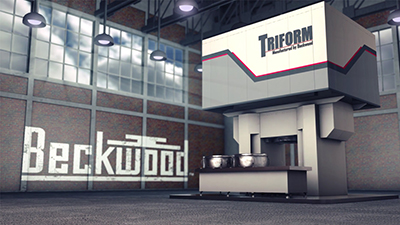Triform’s deep draw sheet hydroforming presses offer unmatched precision and draw depth in low-volume, high-mix production environments. Commonly found in aerospace, medical, and electronics manufacturing facilities, these machines are ideal for creating cans, boxes, and parts with curved flanges, which have a tendency to wrinkle and tear during formation.
How does deep draw sheet hydroforming work?
Triform’s deep draw sheet hydroforming presses use an intuitive controls system in conjunction with a pressurized rubber diaphragm to form domes and hemispheres up to 12” deep in a single cycle. When the chamber closes, the diaphragm pressurizes while the tool extends on a hydraulic cylinder, drawing the material into the diaphragm. Since the diaphragm acts as a universal female die half, you don’t need mated die sets. This reduces tooling costs by 50% -90% compared with conventional press tooling! Additionally, tools can be made from a variety of materials including steel, aluminum, 3D printed substrates, epoxies, and even wood.
Advantages
The main advantage of deep draw sheet hydroforming is its capacity to form deeper parts compared to traditional draw machines. Hydroform deep draw parts can range from 1-in. to 42-in. in diameter with heights up to 12-in. tall. Diaphragm pressure and punch position can be tightly controlled (to 1% of full scale and +/-0.002” respectively), resulting in smooth, uniform, scratch-free parts with no secondary finishing required. The strict control of material flow also eliminates wrinkles and tears.
Another advantage of Triform deep draw sheet hydroforming machines is the ability to convert them into fluid cell presses by simply replacing the draw ring with one that is solid. From there, operators can run the machine in fluid cell mode and make near-net-shaped parts with ease.
Triform’s ‘In-Sight’ feature on deep draw sheet hydroforming presses allows you to pause the cycle at any point in the forming to inspect the results. Depending on those results, you can continue the cycle or abort it to modify the recipe. This ability to look inside the chamber during formation greatly expedites new part development, saving valuable time and materials.
WHITEPAPER: Dive into hydroforming part formation


